I recently was confronted with the statement that “there is no evidence that organic food is any healthier”. Really? In the beginning, all food was organic. And God said that it was good.
“Then God said, “I give you every seed-bearing plant on the face of the whole earth and every tree that has fruit with seed in it. They will be yours for food.” Genesis 1:29
That was before the Fall, of course. The Fall into sin affected the whole creation, not just man. The result was weeds, thistles, disease, pests, and poisonous plants. The curse will be removed when Jesus returns and makes all things right again and forever.
“…that the creation itself will be liberated from its bondage to decay and brought into the freedom and glory of the children of God. We know that the whole creation has been groaning as in the pains of childbirth right up to the present time.” Romans 8:21-22
In the beginning, all green plants were good to eat. Now, we have to work by the ‘sweat of our brow’ to grow good food.
“Be patient, then, brothers and sisters, until the Lord’s coming. See how the farmer waits for the land to yield its valuable crop, patiently waiting for the autumn and spring rains.” James 5:7
Even after the Fall and the curse, there are still a lot of good things for us to rejoice about. lyrics from the hymn:
first, what is organic food?
Organic food is supposed to be food that was grown without pesticides or herbicides, and food that was not processed with chemical additives or preservatives or genetically modified. This could be extended to include not only fruits and vegetables, but meat that was raised on open pasture that had not been sprayed, and meat from livestock that had not been fed processed feed laced with ‘growth hormones’.
why isn’t there any evidence that organic food is healthier for us?
The answer is simple enough. The ‘evidence’ would have to come from scientific research, and there isn’t any financial incentive to do that research.
The money for grants and funding of research and political lobbying is provided by those who hope to get a return on their investment. Pharmaceutical companies earn billions of dollars in profits from their sale of drugs, so they have huge research budgets.
Chemical companies make billions from the sale of pesticides, herbicides and fertilizers.
No one makes any money from the growing of organic foods, so no one invests in research to see if there are benefits. In fact, farmers that grow organic food have a rather tough time making a profit. Their yields are lower and their labor is more intensive. They have to ask for higher prices for their produce to make ends meet.
if you have the time, home-grown organic gardening is the ideal
We shouldn’t need scientific evidence for this. It seems pretty obvious. Herbicides kill plants. Pesticides kill bugs and microorganisms. It’s not a big jump to suggest that they might be bad for you. So avoiding them as much as you can is a no-brainer.
gardening can be fun
I love to watch things grow. I like working outdoors. I like getting ‘down to earth’. I’ve sold my rototiller and turn the soil by shovel or fork when needed. Being retired, I have the time and need the exercise. I stay on top of the weeding by doing a little bit every day unless the weather is really bad.
do the best you can
Not everyone has the time or space to grow their own food, and not everyone can afford to pay extra for organic produce, but they need to do the best they can to stay healthy. Again, it takes more time, but preparing meals from fresh produce (even if it’s not labelled ‘organic’) is better than a steady diet of processed foods.
It doesn’t take that long to do your own cooking, actually – and part of that time can be double tasking while waiting for the meal to heat up and cook. The fresh produce and home cooking is less expensive than buying prepared foods, so that’s an advantage that makes up for the time.
I discovered that I enjoy cooking. It’s an adventure. Just ask my wife!
Most people could at least cook their own supper at the end of their work day. What would you do with the time saved from take-out or frozen dinners? Watch TV?
Lunch can be inexpensive and healthier by ‘brown-bagging’. A whole grain peanut butter and jelly sandwich will do. You’ll save money and be healthier than grabbing lunch at a fast food place. (I confess – I eat at fast food places when I’m in town – but that’s only a couple times a week in my case, out of 21 meals a week.)
gardening in small spaces
Even an apartment dweller can grow a few things in a window or on a patio, and someone on a city lot can grow quite a bit if they dig up that yard space where there’s some sunlight. In suitable locations, putting the whole yard into garden space and things like blueberry bushes will not only be more productive than grass; it will save you money on a lawnmower, gas, and mower repairs!
If you have children, enlist their help in the garden, weeding, composting, mulching, harvesting, cooking, and preserving. The dividends will be with them for the rest of their lives. In our town of Sandy, we have a farmers’ market and a group of volunteers that are teaching young folks various skills, including gardening. You can read about it here. We also have a seed savers’ exchange in our library. (use search bar for “seed saving”)
Another way for urban dwellers to get into gardening is through community gardens - check out this link to get some great ideas and how to find them.
Gardening keeps me in tune with the seasons, the weather, the timing of soil preparation, seed-starting, planting, watering, harvesting, picking and cooking and preserving when things are at their peak, and in my moderate Oregon climate, I can even grow some things all winter (usually).
There is so much to learn, and believe me, I’m still learning. We are at 1100’ elevation. Some things grow well here, and some things don’t. Some seed varieties like it here better than others.
Our fruit trees have good years and bad years. Our fruit is rarely perfect - often there are some defects like scabs or worms, because I don’t use chemical sprays. I just cut out the bad spots. The worst apples can still be salvaged to make excellent applesauce - the good parts are delicious. The not so bad ones have enough good parts to make nice slices for apple pies.
It’s amazing how different fruits ripen at different times, so I have a long secession of fruits that can be cut up and put on my oatmeal every morning. First are strawberries, then blueberries (I have 3 varieties - early, mid-season, and late), then pie cherries, then early apples, then Asian pears and Bartlet pears, along with different varieties of apples that ripen later, then figs, then hardy kiwis. (When we moved from upstate New York to Oregon about 60 years ago, I was surprised to find that figs could be grown here, and had never heard of hardy kiwis.) Blackberries grow wild down behind our woods. This year we had a good crop of hazlenuts, which are delicious when salted and roasted, but they are a lot of work to get out of the shell.
We grow some of our own herbs, like sage, rosemary, chives, and oregano, which I’ve been learning to use in cooking. I also do some foraging in our woods for miners lettuce and mushrooms, and plaintain and young dandelion leaves in the field.
Vegetable seeds don’t all go in the garden at the same time. Some need to be started indoors about 6 weeks before the last average frost date, which in our location is April 19th, so plants that like warm weather are started inside by early March. But veggies that like cool weather, like peas, lettuce, and the cabbage family, can be sown right in the garden as soon as the soil can be worked - which means as soon as the snow melts and the soil dries out enough to be worked without getting muddy. Working the soil includes mixing in compost and manure. There is a Black Angus beef ranch 1/2 a mile away and they let me have manure for free if I clean it out of the barn myself- LOL.
We had to fence our garden because the deer don’t just nibble a little here and there - there are certain things they like so much they’ll wipe them out - like carrots and lettuce and cabbage and broccoli and peas corn and kale and chard and sometimes they’ll even eat the onions. The only things they’ve left alone are potatoes (usually), tomatoes, and squash - so I can plant those in an area outside the fence.
I’ve learned about how much we can eat before lettuce and peas are no longer at their peak, so I plant a small row, then a few weeks after it gets started, I plant a little more, and so on - so we’re always eating fresh, young, prime plants. Same with corn. We can only eat so much before it gets past its prime, so I plant it in 3 batches so it doesn’t all get ripe at once. Corn is best planted in square blocks rather than single rows, because it’s wind-pollinated. When I was a boy in N.Y., I heard some old farmer say the best time to plant corn is when the leaves are full out in the maple trees. I found the same rule of thumb works in Oregon.
I usually have some kale and some chard growing almost all year. A hard freeze will kill the tops, but not the roots, so as soon as it warms up a little, it resumes putting out new leaves. It’s amazing.
About the time the first blueberries are ripe, we can start picking some fresh lettuce and peas, then radishes. Carrots grow slowly, but we get baby carrots when thinning the row. Tomatoes and peppers and beans and corn come later.
Some things can be planted for a fall/winter crop - in fact, Fall is the recommended time to plant garlic. But for the chard, kale, and cabbage family (cabbage, brussel sprouts, cauliflower, and broccoli) a second crop is doable by planting in late summer.
I hate to waste things - when Jesus fed the 5000, he had the disciples pick up all the pieces that fell on the ground so nothing would be wasted. For that reason, I’ve explored drying, canning, and freezing when there’s more food than we can eat right away. Maybe I’ll write some more on preservation methods later.
I built a little root cellar by digging a 4X5 hole about 3’ deep. I used scrap roofing metal from when I built my shop to make a form, then poured some concrete in between it and the soil, then covered it with a corrugated metal, hinged top, with a couple screened holes just above ground level for a little ventilation. I cut a 2” thick foam insulation board to fit on the top (not shown). The in-ground temperature and humidity is pretty constant. I use it mostly for apples and carrots. It keeps them cool so they last longer.
This year I finally succeeded with cabbage and celery. I searched the internet for what to do with it. I found a recipe and just finished cooking my 4th batch yesterday. I love it because I can add whatever we have plenty of - it’s like making stew - you throw in just about anything and everything. Besides the vegetables, it has 1.5 lbs fresh ground beef and a good bit of rice. (I use brown rice.) It makes enough to last Bev and I for a week, but I’m afraid she might get sick of it if we eat the same thing every night, so I give some away and invite friends over for supper - or I freeze some.
Recently I’ve been having a blast learning how to cook, and I found out I really enjoy it. There’s something about raising your own food, picking and eating it fresh, or picking it fresh and throwing it right in the pot, and learning how to make it really taste great, knowing all along that all this is good for your health…it’s very satisfying. I made Zuccinni bread, apple pie, blueberry pie as usual this year. But this was a first for fried egg plant, fig compote, and home-made pumpkin pie from scratch. God is good.
Here’s the recipe for beef cabbage soup:
As time permits, I’ll write about propagation methods. Seeds aren’t the only way. Cuttings, grafts, and layering are arts in themselves.




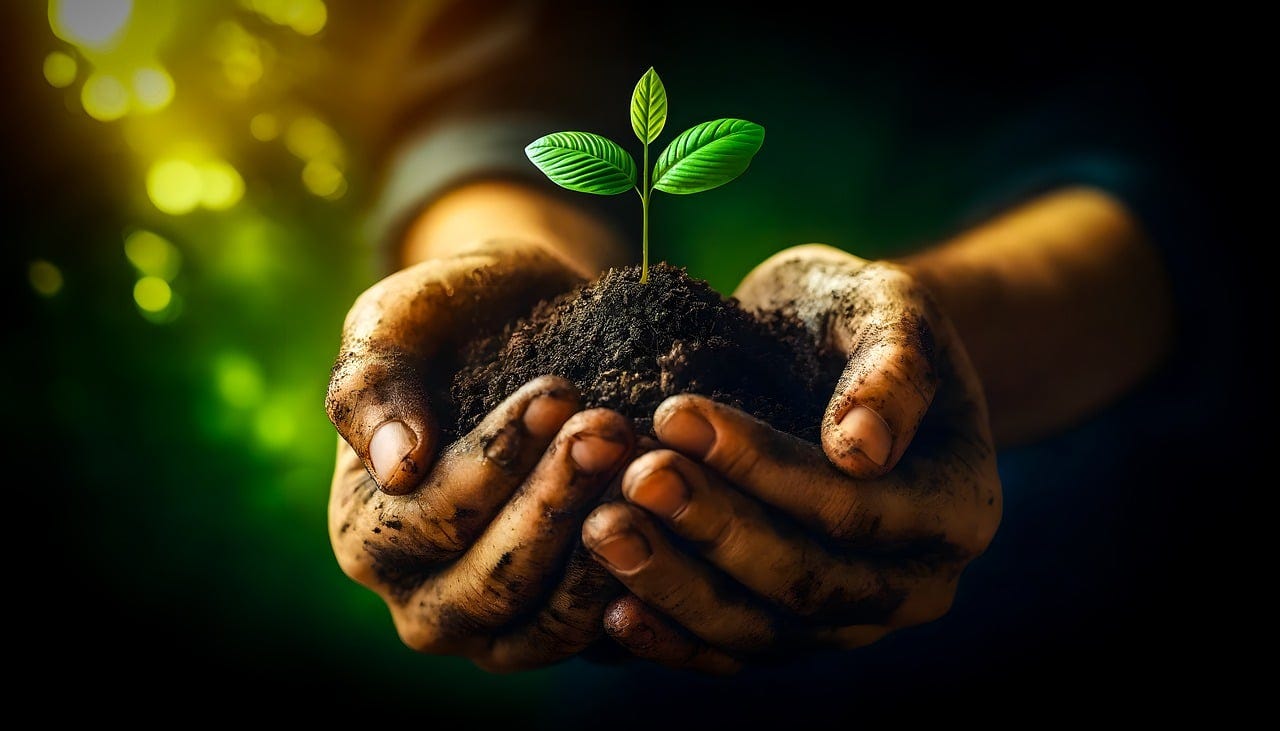
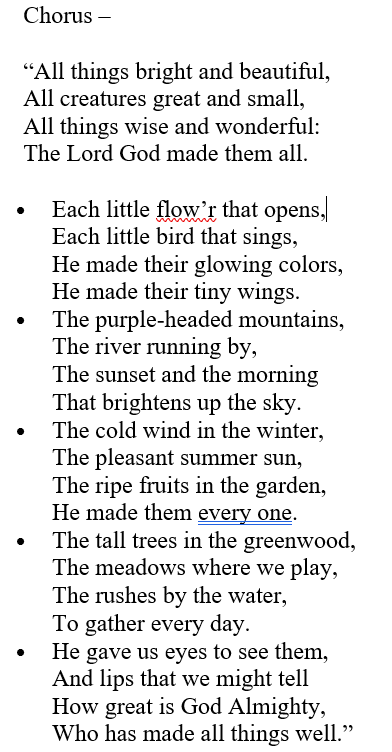
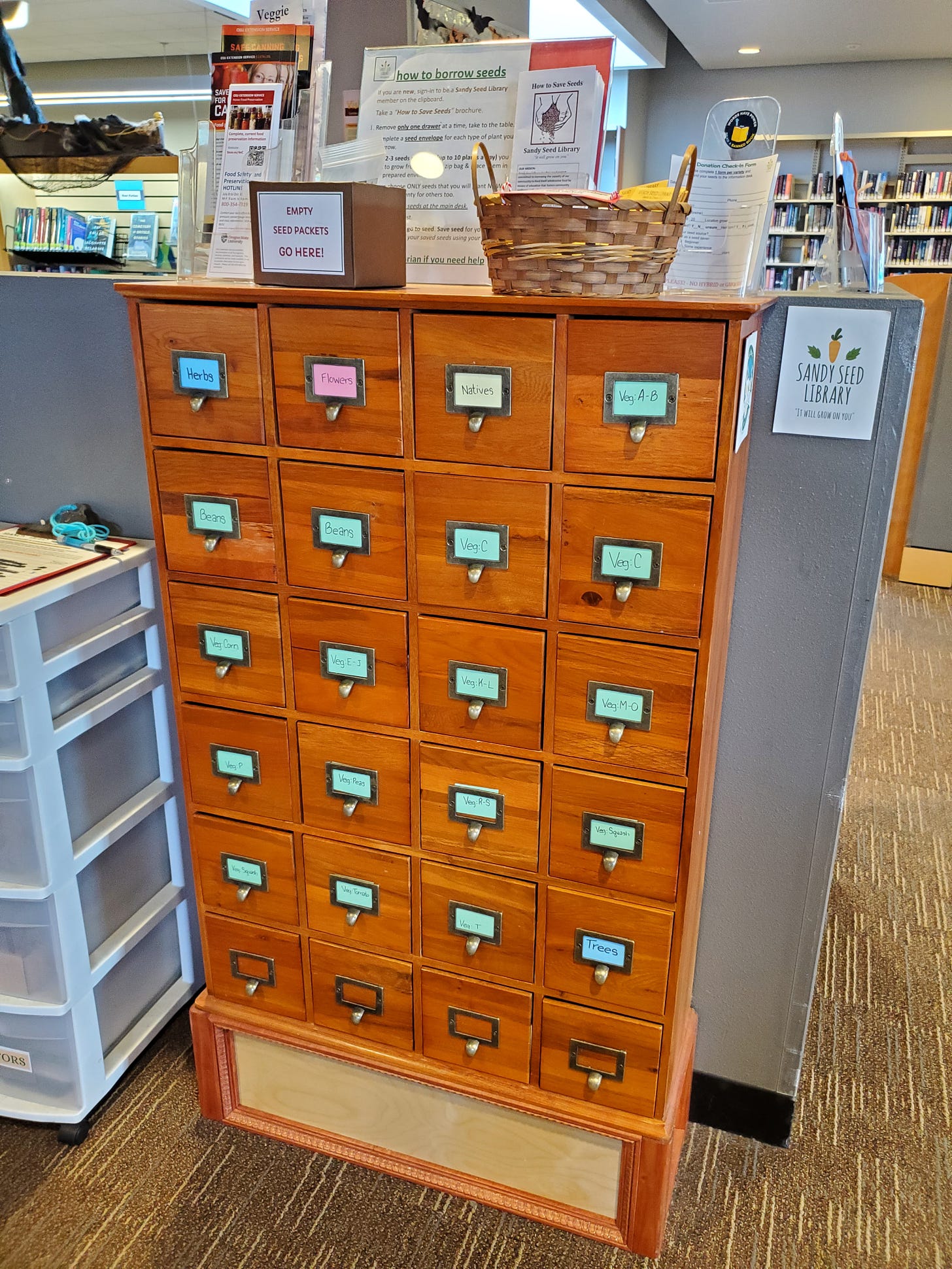
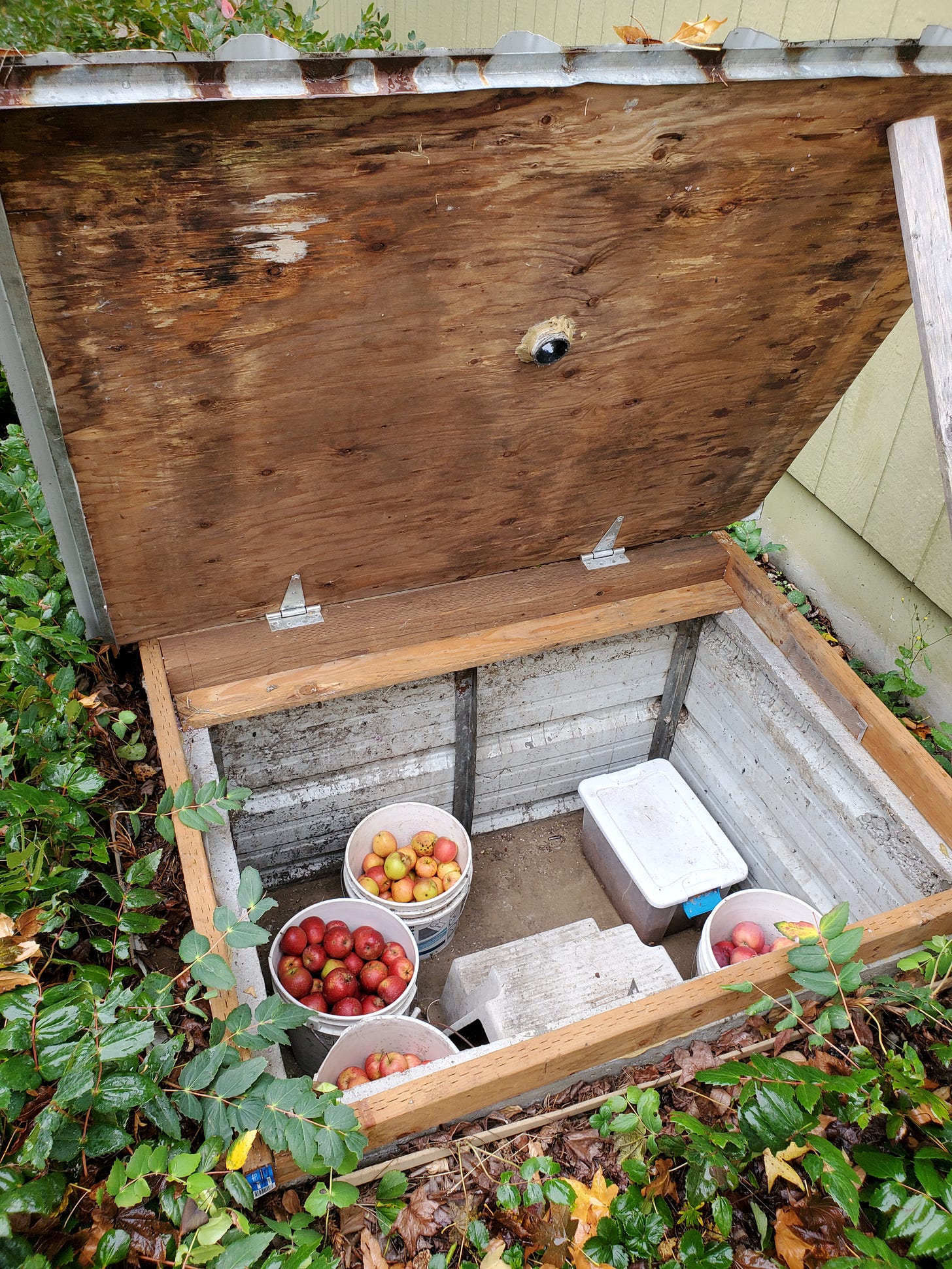
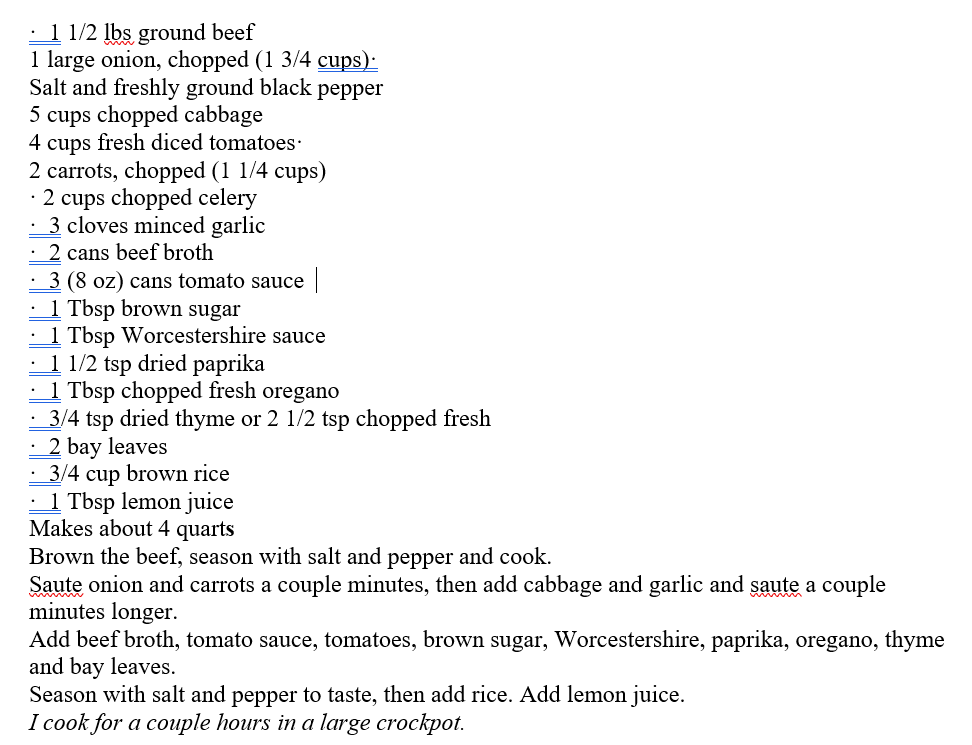
I am living with my youngest son, Sam. I have a plot of his "side yard" covered with cardboard so I can dig up for garden space. I helped him empty his garage so it would be converted into a room for me. We found two shelves in the garage we had to remove. They were 2x12x 20 feet. Hard as nails. I'll have to cut them to length of what I can dig up. Sam is not an outdoor type with yard work. He does mow, but leaves the pine cones on the ground. I have raked up the pine needles and pine cones and thought of running then through a chipper but the advertisement for the chippers say "they don't work on pine cones." So my compost pile is about 6 feet wide by 7 feet long and 3 feet high. I will try to turn it some but I do hope it starts composting. Oh, some pine cones are still falling at irregular times that I add to the pile as well as the new fallen needles. I watered it well and then added some bark chips that were growing grey mushrooms. Maybe that will be some "compost starter."
I have been trying to clean the fence line of dead and dying arborvitae trees with the green ivy. The nursery said nothing much works to kill it, just keep pulling it out.
maybe I'll have to write this up and post it on my stubstack.com.
I received this important qualifier and very well-informed comment from a friend, reminding me that organic is OK for a home garden, but not efficient for larger scale:
"While I agree with your concerns about genetically modified plants and the like (even excessive reliance on hybrids), having grown up on the other side of the world, I have a slightly different view of "organic" farming. My conclusion is that growing an "organic" garden for personal use is one thing. But trying it in large scale farming leads to disaster. Take India for example. It was a case of endemic food shortages and starvation. Then the "Green Revolution" happened during the late 1960s and following. This was an effort spearheaded by the West (mostly America) to improve agricultural output. As a result of using high-yield seed, fungicides, fertilizers, etc. the farm output of India increased dramatically. Though there are still many who live on subsistence diets, India has become a net exporter of food. Much suffering was alleviated and life spans have increased. I witnessed the same thing in Pakistan. The people are far better fed now than when we moved there in 1960.
A negative example is what happened just a couple of years ago in Sri Lanka. There the government bought into the "save the environment" rhetoric and banned the use of industrial fertilizers. The food output plummeted to one quarter of what it had been and people began to starve. They rose up and kicked the government out.
I've also read that with the introduction of western farming practices in Japan after World War II, the height of the average Japanese increased by four inches. The reduction in malnutrition was that dramatic!
So, while I have no problem whatever with someone going "organic" in their own vegetable patch, I sure wouldn't want to see it mandated on a large scale. Already been there and it wasn't pretty!"